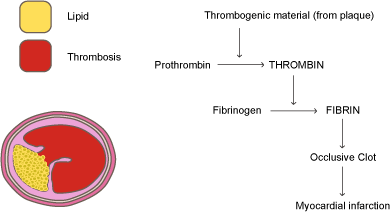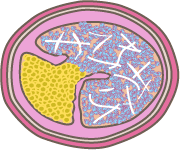Cardiology Teaching Package
A Beginners Guide to Normal Heart Function, Sinus Rhythm & Common Cardiac Arrhythmias
The Role of Fibrin in Clot Formation
The picture below shows the clotting cascade initiated when "thrombogenic" material is released from a plaque rupture. FIBRIN is the critical development here as it binds all the components of a clot together.
In the second picture you can see the fibrin threads within a clot. You can also see platelets and other elements trapped in the fibrin mesh.
Image: Thrombosis

Once Fibrin is formed, anything circulating within the blood will adhere to the forming clot. In the above picture you can see that the soft lipid core is no longer contained as the fibrous cap has ruptured, starting a cascade effect leading to clot formation.
However, the clot is not always completed and can lead to a further reduction in the size of the lumen of the artery and worsening ischaemic symptoms.
Below you can see actual fibrin threads and an example of how they work within a clot to bind it together.
Image: Thrombus Formation - Fibrin Threads

